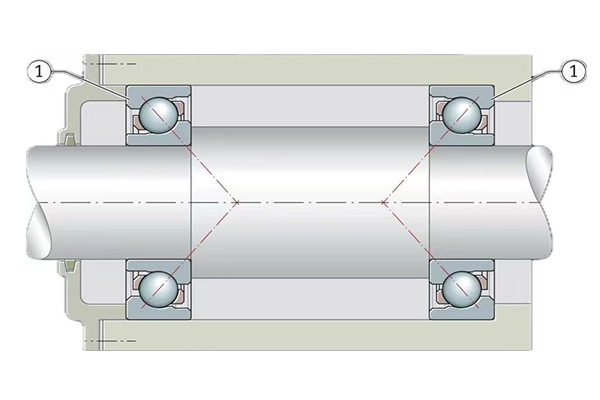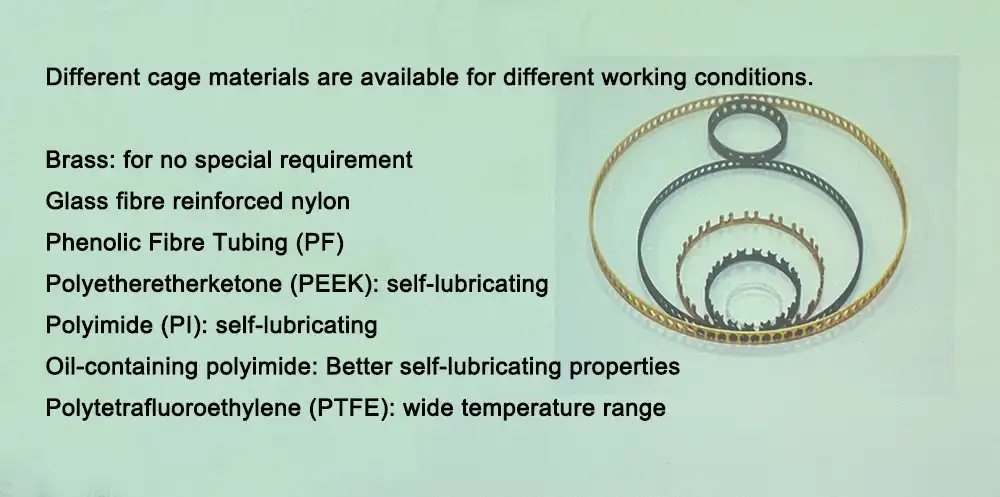What are the Typical Materials Used for the Cages in Angular Contact Ball Bearings?
Angular contact ball bearings are crucial components in various mechanical applications, and the materials used in their cage construction play a vital role in their performance and durability. The cage, also known as the retainer or separator, keeps the rolling elements properly spaced and prevents them from making contact with each other during operation. The selection of cage materials is critical as it directly impacts the bearing's speed capabilities, operating temperature range, and overall reliability. Modern manufacturing processes and material science advancements have significantly expanded the range of available cage materials, each offering distinct advantages for specific applications.

The evolution of bearing cage materials has been driven by increasingly demanding industrial requirements, particularly in high-speed machinery, aerospace applications, and precision equipment. These applications often operate under extreme conditions, requiring materials that can maintain their structural integrity while providing optimal performance characteristics. The development of new materials and manufacturing techniques has led to substantial improvements in bearing life, reliability, and operational efficiency.
How do different cage materials affect the performance of angular contact ball bearings?
The choice of cage material significantly influences bearing performance characteristics and operating conditions. Traditionally, pressed steel cages were the standard, but modern applications have led to the development of various alternative materials to meet specific requirements.

Brass cages remain a popular choice for high-speed applications due to their excellent machinability and good thermal conductivity. These properties allow for precise manufacturing and efficient heat dissipation during operation. Brass cages are particularly valuable in applications where maintaining dimensional stability under varying temperatures is crucial. The material's inherent strength and durability make it suitable for heavy-duty applications, while its good friction characteristics contribute to smooth angular contact ball bearing operation. Additionally, brass cages can be manufactured with high precision, allowing for optimal pocket geometry and surface finish that enhance lubricant retention and distribution.

Polyamide (PA66) cages have gained prominence in recent years, offering several advantages over metallic alternatives. These polymer cages are lightweight, reducing centrifugal forces at high speeds, and provide excellent self-lubricating properties. The material's inherent flexibility helps absorb shock loads and reduce noise levels during operation. Modern polyamide materials often incorporate glass fiber reinforcement to enhance strength and dimensional stability. The ability to mold complex geometries allows for optimized designs that improve lubricant flow and reduce operating temperatures. PA66 cages also offer excellent chemical resistance and can operate effectively in a wide range of environments.

Phenolic resin cages, typically reinforced with cotton fabric, offer an excellent balance of mechanical properties. They provide good wear resistance and can operate effectively in oil-lubricated applications. These cages maintain their strength at elevated temperatures and demonstrate good chemical resistance to common lubricants. The material's natural damping properties help reduce vibration and noise, while its relatively low cost makes it an attractive option for many industrial applications. Phenolic cages are particularly effective in applications where consistent performance over extended periods is required.
PEEK (Polyether Ether Ketone) cages represent the cutting edge in bearing cage technology. This high-performance polymer offers exceptional mechanical properties, chemical resistance, and thermal stability. PEEK cages can operate at temperatures up to 260°C while maintaining their dimensional stability and mechanical strength, making them ideal for aerospace and other demanding applications. The material's inherent lubricity and wear resistance contribute to extended bearing life, while its chemical inertness allows for use with aggressive lubricants and in corrosive environments. PEEK's high strength-to-weight ratio and excellent fatigue resistance make it particularly suitable for high-speed applications where traditional materials might fail.
What factors determine the selection of bearing cage materials for specific applications?
The selection of appropriate cage materials involves careful consideration of multiple operating parameters and environmental conditions. Understanding these factors is essential for optimal bearing performance and reliability.
Operating temperature is a primary consideration in cage material selection. While polymer cages like PA66 typically operate well up to 120°C, applications requiring higher temperature capability may necessitate the use of PEEK or metallic cages. The temperature range also affects the cage material's dimensional stability and mechanical properties, which must be maintained within acceptable limits throughout the operating range. Temperature cycling can induce thermal stresses and potential dimensional changes, making material stability crucial for maintaining proper angular contact ball bearing function.
Speed requirements significantly influence cage material choice. High-speed applications often benefit from lightweight polymer cages that reduce centrifugal forces and minimize friction. However, very high-speed applications may require specially designed brass cages that offer superior stability and heat dissipation characteristics. The cage material must maintain its structural integrity under the centrifugal forces generated at operating speed while providing adequate guidance to the rolling elements.
Lubrication compatibility must be carefully evaluated when selecting cage materials. Some polymer materials may degrade when exposed to certain lubricants or additives. Metallic cages generally offer good compatibility with most lubricants but may require special surface treatments to optimize their performance. The cage material should also facilitate proper lubricant distribution and retention within the bearing assembly.
Environmental conditions, including exposure to chemicals, moisture, and contamination, play a crucial role in material selection. PEEK and certain polymer materials offer excellent chemical resistance, while metallic cages may require special protective coatings in corrosive environments. The presence of particulate contamination can accelerate wear, making the material's inherent wear resistance an important consideration.
Load conditions and shock resistance requirements also influence cage material selection. Polymer cages often provide better shock absorption characteristics, while metallic cages may be preferred in applications with very heavy loads or severe impact conditions. The cage must maintain proper rolling element guidance under all anticipated operating conditions while resisting deformation and wear.
What are the latest innovations in bearing cage materials and design?
The field of angular contact ball bearing cage materials continues to evolve with new developments in materials science and manufacturing technologies. Recent innovations have focused on enhancing performance characteristics while addressing sustainability concerns.
Hybrid materials and composites represent a significant advancement in cage design. These materials combine the benefits of different material types to achieve optimal performance characteristics. For example, carbon fiber-reinforced PEEK cages offer exceptional strength-to-weight ratios and thermal stability, while maintaining the beneficial properties of traditional PEEK materials. Novel composite structures incorporating nanomaterials are being developed to enhance specific properties such as wear resistance and thermal conductivity.
Advanced surface treatments and coatings have emerged as effective ways to enhance the performance of traditional cage materials. These treatments can improve wear resistance, reduce friction, and provide better protection against corrosion. For metallic cages, techniques such as physical vapor deposition (PVD) coating can significantly extend service life and improve performance under demanding conditions. Diamond-like carbon (DLC) coatings are being increasingly used to provide exceptional wear resistance and low friction characteristics.
Additive manufacturing technologies are revolutionizing cage design and production. 3D printing allows for the creation of complex cage geometries that optimize lubricant flow and reduce weight while maintaining structural integrity. This technology also enables the use of new materials and material combinations that were previously impossible to manufacture using traditional methods. Advanced manufacturing techniques allow for the integration of features such as improved lubricant channels and optimized pocket designs.
Sustainable materials are gaining attention in bearing cage design. Bio-based polymers and recyclable materials are being developed and tested for use in less demanding applications. These materials offer environmental benefits while maintaining acceptable performance characteristics. Research is ongoing into biodegradable polymers that could provide suitable mechanical properties while reducing environmental impact.
Smart materials that can adapt to changing operating conditions are being researched for next-generation bearing applications. These materials could potentially adjust their properties based on temperature, load, or other operating parameters, offering unprecedented levels of performance optimization. Integration of sensors and smart materials could enable real-time monitoring of angular contact ball bearing conditions and predictive maintenance capabilities.
The development of self-lubricating materials and surface treatments continues to advance, with new compositions offering improved performance and longer service life. These innovations reduce maintenance requirements and enhance reliability in applications where traditional lubrication methods are impractical or insufficient.
Luoyang Huigong Bearing Technology Co., Ltd. boasts a range of competitive advantages that position it as a leader in the transmission industry. Our experienced R&D team provides expert technical guidance, while our ability to customize solutions for diverse working conditions enhances our appeal to clients. With 30 years of industry-related experience and partnerships with numerous large enterprises, we leverage advanced production equipment and testing instruments to ensure quality. Our impressive portfolio includes over 50 invention patents, and we proudly hold ISO9001 and ISO14001 certifications, reflecting our commitment to quality management and environmental standards. Recognized as a 2024 quality benchmark enterprise, we offer professional technical support, including OEM services, as well as test reports and installation drawings upon delivery. Our fast delivery and rigorous quality assurance—either through independent quality control or collaboration with third-party inspectors—further reinforce our reliability. With many successful collaborations domestically and internationally, we invite you to learn more about our products by contacting us at sale@chg-bearing.com or calling our hotline at +86-0379-65793878.
References:
1. SKF Bearing Technical Manual (2023). "Advanced Materials in Rolling Bearings"
2. NSK Engineering Journal (2024). "Development of High-Performance Bearing Cages"
3. Journal of Tribology International (2023). "Materials Evolution in Rolling Element Bearings"
4. Timken Company Technical Series (2023). "Bearing Cage Design and Material Selection"
5. FAG Schaeffler Technical Guide (2024). "Modern Bearing Components"
6. JTEKT Engineering Journal (2023). "Innovations in Bearing Cage Materials"
7. Applied Sciences Journal (2024). "Advanced Polymers in Bearing Applications"
8. Materials Science and Engineering Review (2023). "Composite Materials in Mechanical Components"
9. Tribology Transactions (2024). "Performance Analysis of Bearing Cage Materials"
10. IEEE Engineering Review (2023). "Smart Materials in Bearing Applications"

